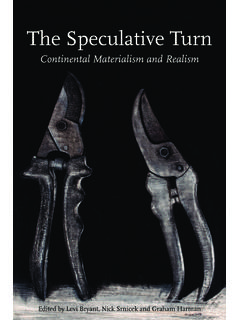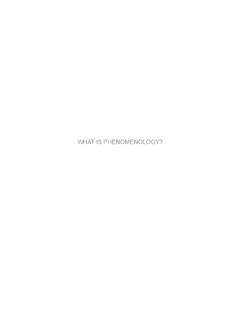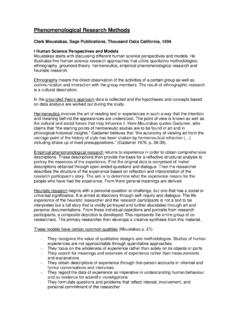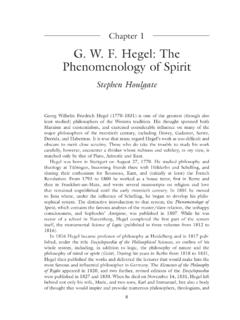Transcription of A Phenomenology - re-press.org
1 First loveSigi J ttkandtA Phenomenology of the OneSigi J ttkandtfirst love: A Phenomenology of the One Open Access Statement Please ReadThis book is Open Access. This work is not simply an electronic book; it is the open access version of a work that exists in a number of forms, the traditional printed form being one of them. Copyright NoticeThis work is Open Access , published under a creative commons license which means that you are free to copy, distribute, display, and perform the work as long as you clearly attribute the work to the authors, that you do not use this work for any commercial gain in any form and that you in no way alter, transform or build on the work outside of its use in normal academic scholarship without express permission of the author and the publisher of this vol-ume. Furthermore, for any reuse or distribution, you must make clear to others the license terms of this work.
2 For more information see the details of the creative commons licence at this website: means that you can: read and store this document free of charge distribute it for personal use free of charge print sections of the work for personal use read or perform parts of the work in a context where no financial transactions take placeHowever, you cannot: gain financially from the work in anyway sell the work or seek monies in relation to the distribution of the work use the work in any commercial activity of any kind profit a third party indirectly via use or distribution of the work distribute in or through a commercial body (with the exception of academic usage within educational institutions such as schools and universities) reproduce, distribute or store the cover image outside of its function as a cover of this work alter or build on the work outside of normal academic scholarshipCover ArtThe artwork on the cover of this book is not open access and falls under traditional copy-right provisions and thus cannot be reproduced in any way without written permission of the artists and their agents.
3 The cover can be displayed as a complete cover image for the purposes of publicizing this work; however, the artwork cannot be extracted from the context of the cover of this specific work without breaching the artist s / Purchasing BooksThe PDF you are reading is an electronic version of a physical book that can be purchased through any bookseller (including on-line stores), through the normal book supply channels, or directly. Please support this open access publication by requesting that your university purchase a physical printed copy of this book, or by purchasing a copy yourself. If you have any questions please contact the publisher: Box 40 Prahran, 3181 VictoriaAustralia LOVETRANSMISSIONT ransmission denotes the transfer of information, objects or forces from one place to another, from one person to another. Transmission implies urgency, even emergency: a line humming, an alarm sounding, a messenger bearing news.
4 Through Transmission interven-tions are supported, and opinions overturned. Transmission republishes classic works in philoso-phy, as it publishes works that re-examine classical philosophical thought. Transmission is the name for what takes place. Melbourne 2010 Sigi J ttkandtFIRST LOVEA Phenomenology OF THE Box 40, Prahran, 3181, Melbourne, Sigi J ttkandt 2010 The moral rights of the authors have been assertedThis work is Open Access , published under a creative commons license which means that you are free to copy, distribute, display, and perform the work as long as you clearly attribute the work to the authors, that you do not use this work for any commercial gain in any form whatsoever and that you in no way alter, transform or build on the work outside of its use in normal academic scholarship without express permission of the author (or their executors) and the publisher of this volume.
5 For any reuse or distribution, you must make clear to others the license terms of this work. For more information see the details of the creative commons licence at this website: Library Cataloguing-in-Publication DataA catalogue record for this book is available from the British LibraryLibrary of Congress Cataloguing-in-Publication DataA catalogue record for this book is available from the Library of CongressNational Library of Australia Cataloguing-in-Publication DataJottkandt, love : a Phenomenology of the one / Sigi J (pbk.)978-0-9806683-0-8 (ebook)Series: : : Love. Love in and Typeset by A&R This book is produced sustainably using plantation timber, and printed in the destination market reducing wastage and excess vii1. A IS FOR ANNA, OR THERE IS SOME ONE : SAMUEL BECKETT 12.
6 FORFEITS AND COMPARISONS: IVAN TURGENEV 373. IN THE SELF S TEMPORARY LODGINGS: EUDORA WELTY 594. I MARY YOU: JOHN CLARE 875. THE FIRST LOVE IS THE TRUE LOVE AND ONE ONLY LOVES ONCE : S REN KIERKEGAARD WITH EUGENE SCRIBE 121 Afterword 161 Bibliography 167viiACKNOWLEDGEMENTSIf every book has its secret co-author, or at least its one intended reader, here that person is Justin Clemens whose intellectual gen-erosity and creative suggestions have kept me unfailingly aware of how the process of writing is always implicitly a scene of Two . The book s inevitable other reader , then, is Dominiek Hoens, in whose sympathetic company many of the ideas explored here took on their early shape.
7 A portion of the fi rst chapter appeared as The Narcissism of Small Diff erences: On Beckett s First Love in (a): the journal of culture and the unconscious, vol. 3, nos. 1-2, 2003, pp. 117-26. The second chapter appeared as Forfeits and Comparisons: Turgenev s First Love in Lacan: the Silent Partners, Slavoj i ek (ed.), London, Verso, 2006. I thank the editors for permission to reprint this material. I would also like to take this opportunity to thank the Flemish Fund for Scientifi c Research and Ghent University for fi nancial assistance during the writing of this book, and to express my gratitude to the members of the re-search project, A Critique of Literary Ethics: Gert Buelens, Ortwin de Graef and Benjamin Biebuyck. I am also very grateful to the Jan van Eyck Academy for support in the fi nal stages of this writing, as well as to Paul Ashton, Lorenzo Chiesa, Tom Cohen, Joan Copjec, Marc de Kesel, Oliver Feltham, Chris Gemerchak, Gary Hall, Lieven Jonckheere, Juliet Flower MacCannell, J.
8 Hillis Miller, Ed Pluth, Tom Toremans, and the current and former researchers at the Jan van Eyck Circle for Lacanian Ideology Critique. Brussels, 2009for A IS FOR ANNA, OR THERE IS SOME ONE : SAMUEL BECKETT A is for Anna like L is for Liv. Aha hahah, Ante Ann you re apt to ape aunty annalive! Dawn gives rise. Lo, lo, lives love! Eve takes fall. La, la, laugh leaves alass! Aiaaiaiai, Antian, we re last to the lost, Loulou! Tis perfect James Joyce, Finnegan s WakeLet me begin with a claim that must sound astonishing to many ears, John Robert Keller s assertion of the primacy of love in Beckett s Clearly intended as a provocation to contempo-rary Beckett studies, Keller s book, Samuel Beckett and the Primacy of Love, counters a long-running strain in Beckett criticism that has painted Beckett as an unrelentingly pessimistic fi gure, whose bleak vision of humanity is mitigated only by the blackest of black humor.
9 While Keller doesn t deny what he calls the primal ca-tastrophe that many readers have detected shaping the contours of the Beckettian narrator s world, he fi nds Beckett s fi ction to be powerfully infl ected by a courageous attempt at love, at whose center is an attempt to connect to the mother .2 With this, Keller swiftly and economically confi rms what Freud has reportedly taught us all along, such that it has become a truism of psycho-analytic criticism, namely, that the mother is the child s fi rst love . Keller s thesis, worked out through sustained readings of Murphy, Watt, Waiting for Godot and several texts from the short fi ction (although, surprisingly, not the short novella First Love), is that by writing, by telling stories, Beckett s narrator attempts to mend 1 . J o h n R o b e r t K e l l e r , Samuel Beckett and the Primacy of Love, Manchester, Manchester University Press, 2002.
10 2 . K e l l e r , Samuel Beckett and the Primacy of Love, p. Love2the gap that has separated him from the loving otherness that is the maternal being. Writing, Keller asserts, is a desperate plea for connection, by a self that is unifying, then fragmenting under the weight of non-recognition .3 Although Keller s is probably not a Beckett many of us would recognize at fi rst sight, his assessment of the writer as a think-er of utmost perseverance and fortitude would likely gain an ap-preciative nod from Alain Badiou. Badiou s lifelong engagement with Beckett is recorded in a series of essays, recently translated in Alberto Toscano s and Nina Power s useful volume, On In this collection, Badiou speaks of the urgent need to put distance between ourselves and the Sartrean or existentialist Beckett that has dominated Beckett studies for much of the past half century (although, as Andrew Gibson points out in his thoughtful after-word to the volume, Badiou seems largely unaware of the chal-lenge to this characterization posed by more recent studies in the deconst r uc t ive vein).







